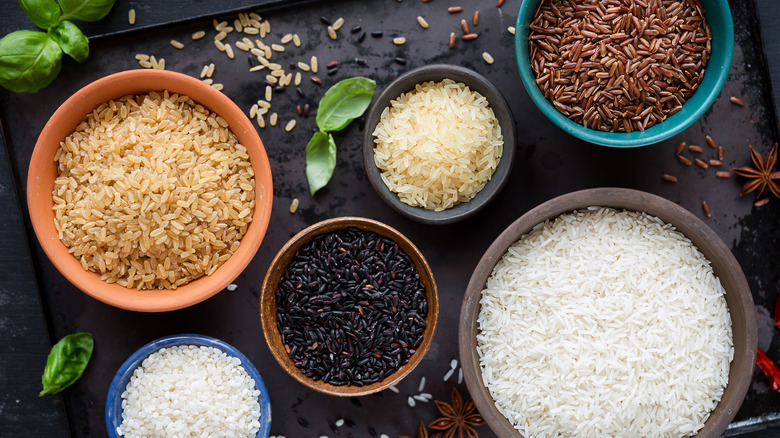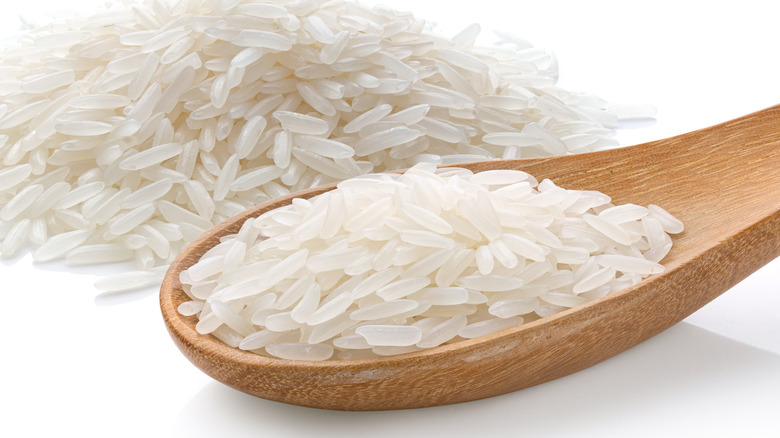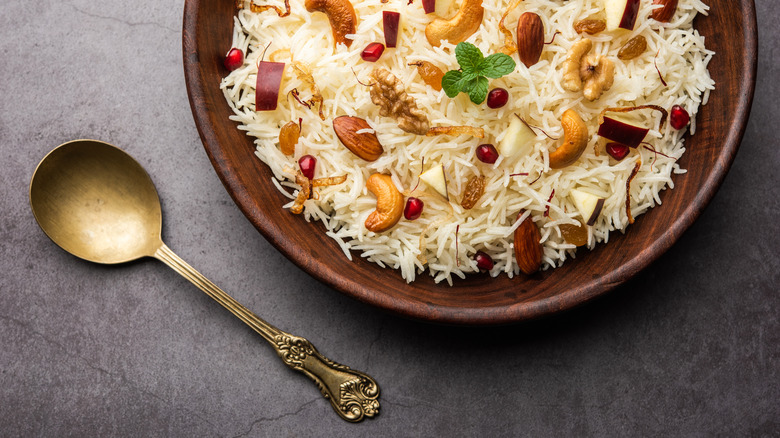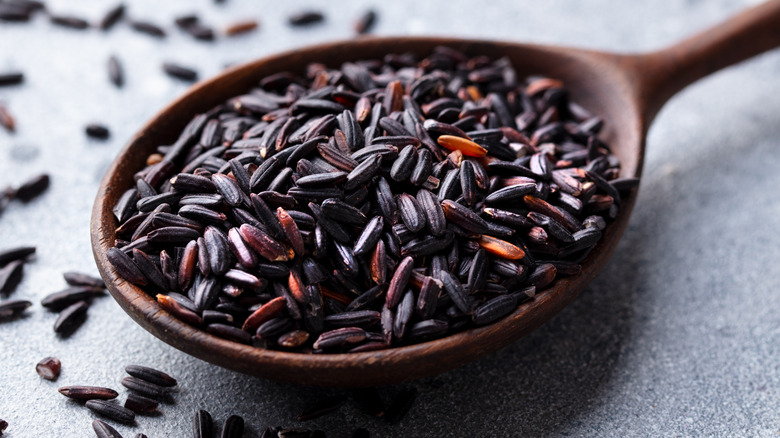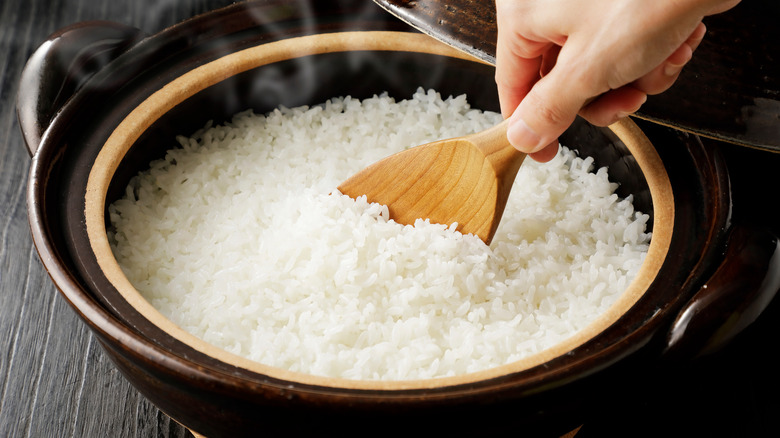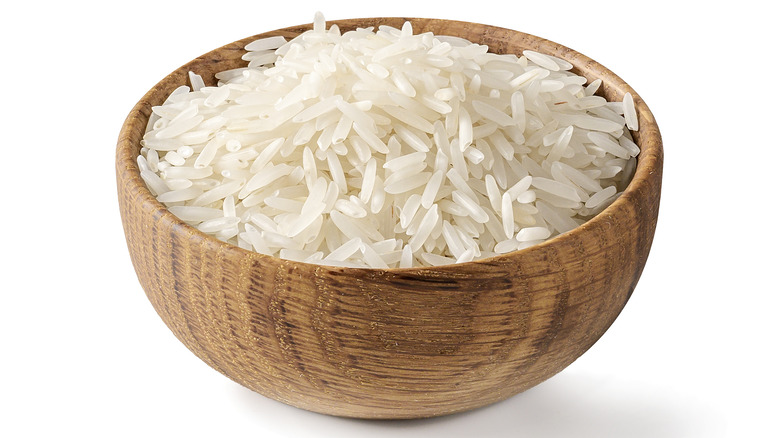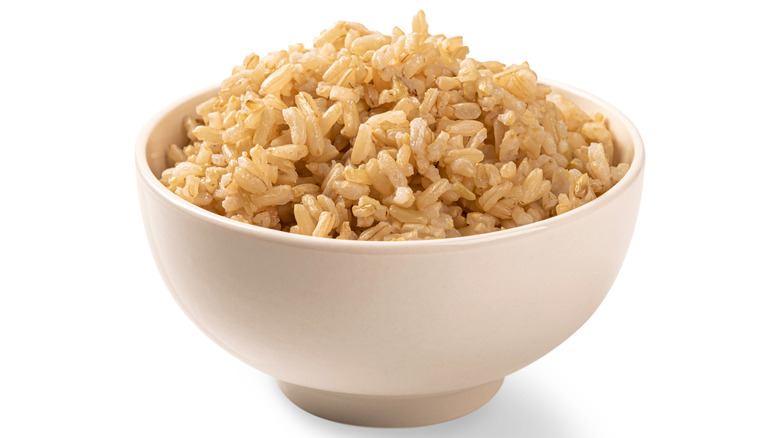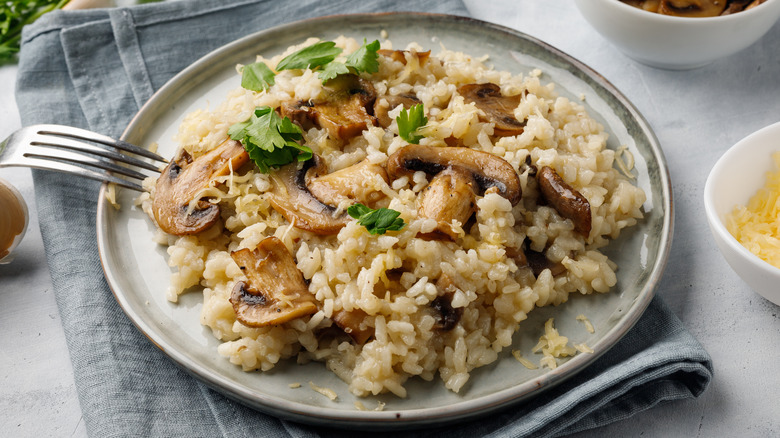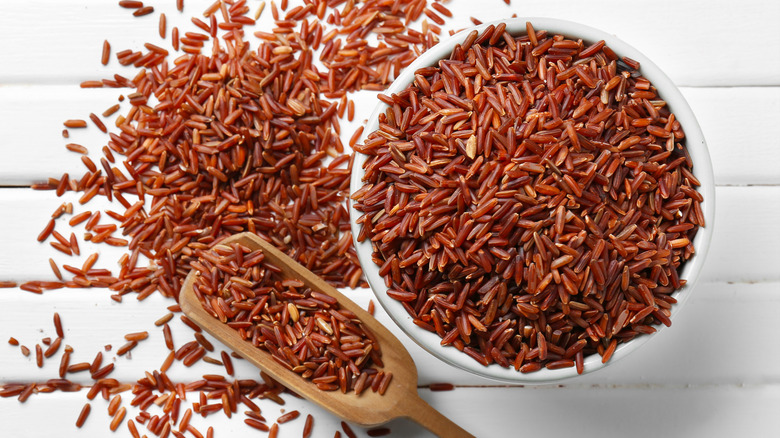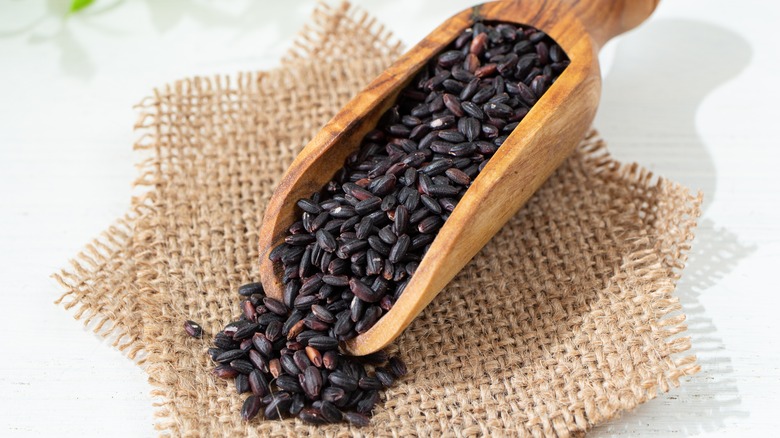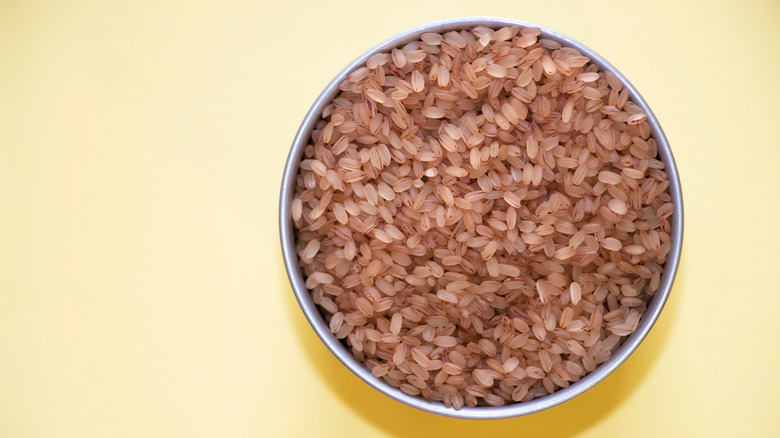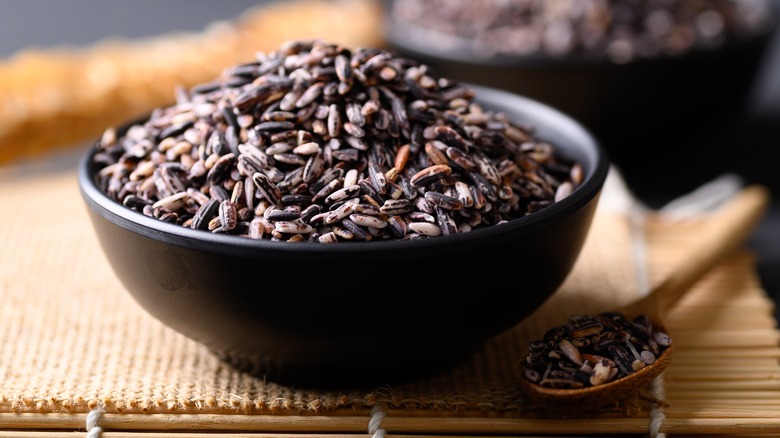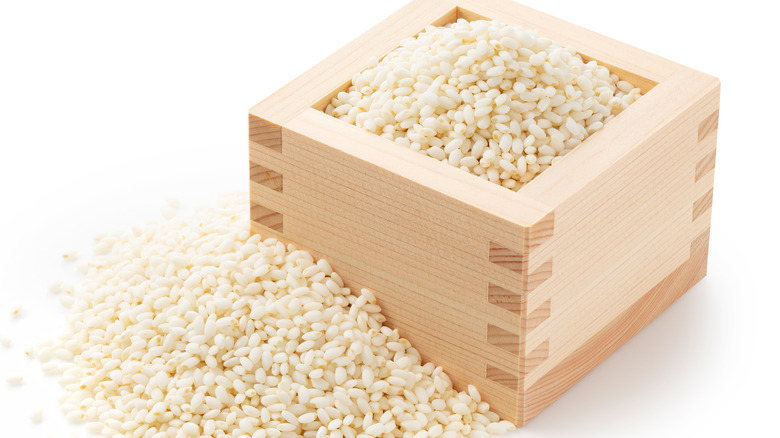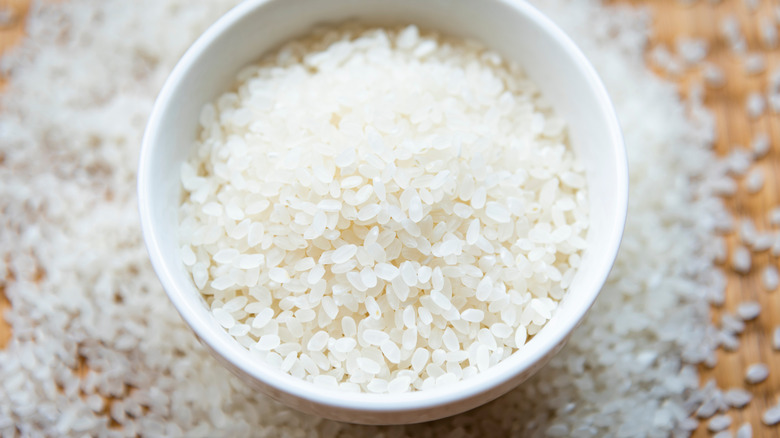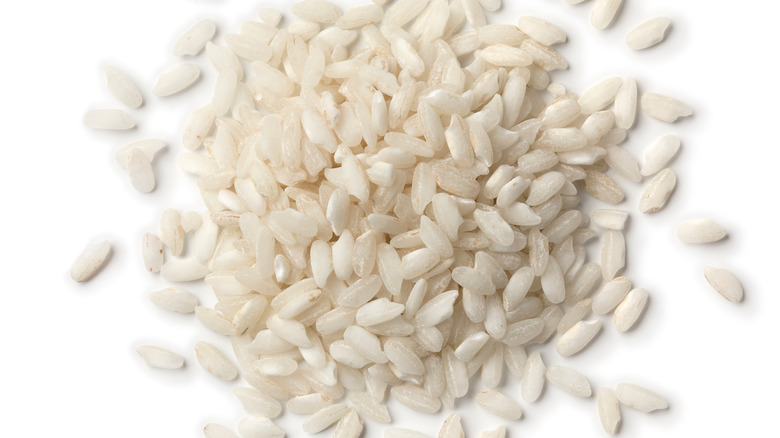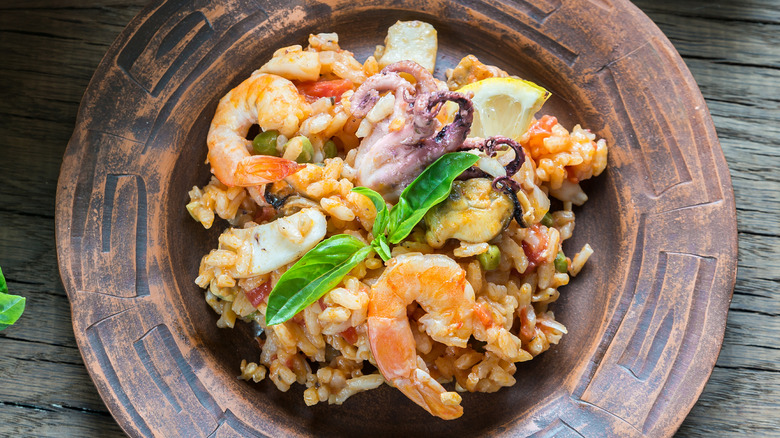15 Types Of Rice And How To Perfectly Cook Them
Rice is one of our favorite types of food. We don't care how you prepare this grain. We love it in any way, shape, or form. And yet, rice sometimes gets a bad rap in the health community for being too high in carbohydrates. But let's face it, your body needs carbs. The carbs you eat might as well be the type that is packed with fiber and nutrients, as opposed to the tasty, yet less healthy carbohydrate alternatives that come from your neighborhood bakery.
From American to Thai to Spanish, rice is the foundation of many beloved, traditional cuisines. We are talking about sushi, stir-fries, pilaf, risotto, arancini, and paella. You've surely encountered a few different varieties of rice in your day as well — after all, there are some 40,000 types of rice in the world today (via Bon Appétit) — but you might not be an expert in cooking rice properly, let alone in preparing a rice dish from scratch in your own kitchen.
Well look no further. This handy guide will walk you through 15 different types of rice and how to perfectly cook each of them. Get those rice recipes ready, we're about to make you a professional in the rice cooking world. Keep reading to become an expert in cooking some of the most well-known rice types out there. Don't worry about having leftover rice ever again either; there are plenty of uses for that as well.
Jasmine Rice
Jasmine rice is a type of rice not uncommon to many kitchens; it's often prepared as rice on the side, used as a base in curries and in stews, or sautéed with vegetables in stir-fries.
Grown typically in Thailand, Cambodia, and Vietnam, jasmine rice comes in various colors, including white, brown, red, purple, and black (via A Couple Cooks). It's also referred to as Thai fragrant rice, known for its subtle buttery flavor. Jasmine rice is most often seen in its white rice form, but the rice is also available as a whole-grain variety, with its brown version offering twice as much fiber content: 2 grams to 1 (via Healthline). Jasmine rice can be used in many different recipes, including dirty rice — a seasoned beef and rice dish.
To cook this type of rice on the stovetop, add 1 ½ cup of water to 1 cup of jasmine rice, cover, and then simmer for 15 minutes (per Mahatma Rice).
Basmati Rice
Basmati rice is a bit longer than jasmine rice and is similarly known for its aroma. India and Pakistan were the first countries to cultivate this type of rice, with India accounting for about 65% of the world's production today, according to Bon Appétit.
Basmati rice has a low to medium glycemic index, which means that it is fairly slow to digest and does not cause the typical blood sugar spike you may see from other types of rice (via Tilda). It also is exceptional because it contains all the essential amino acids that make up protein, in addition to a good amount of folate. Tilda notes that Basmati gets better with age, which means you can store it in your pantry for a long time and the floral notes will become even more prominent as time passes.
To cook basmati rice, bring 1 ¾ quarter cups of water and 1 cup of rice to a boil on the stovetop, then lower to a simmer and cover for 20 minutes (via Mahatma Rice).
Wild Rice
Wild rice is notable because of its fiber content, which is about three times more than that of white rice (per Healthline). As most Americans do not consume enough fiber in an average day, adding wild rice to your diet may be a great way to increase your overall intake of fiber. Additionally, a study published in the Journal of Agriculture and Food Chemistry found that wild rice had 30 times more antioxidant activity than white rice. This is excellent news for wild rice eaters, as antioxidants are a natural neutralizer of cell-damaging free radicals in the body.
To cook wild rice on the stovetop, add 4 cups of water and 1 cup of wild rice to a small saucepan. Bring this mixture to a boil and then lower it to a simmer. Cover the pan with a lid and allow the wild rice to cook for 45 minutes (per Allrecipes).
Sushi Rice
Sushi rice is a Japanese short grain rice, and in true, authentic Japanese cuisine, only sushi rice is used to make sushi (via Just One Cookbook). This type of rice is not used in any other dishes.
To make sushi rice, you season the rice with a mixture of rice vinegar, sugar, salt, and kombu. You start with 3 ½ cups of uncooked white short grain rice and 1 ½ cups of water. Add this combination to a rice cooker and place the piece of kombu on top. Cook until the rice is done. Then remove and stir in the seasoned rice vinegar. If you are planning on keeping this sushi rice for a few hours until using, be sure to cover with a damp towel. Then when ready, form into sushi rolls, such as in this recipe for spicy crab salad sushi rolls. Serve your sushi up with chopsticks, or not (if you are a real pro).
Long Grain Rice
Long grain rice is an overarching umbrella term. This type of rice includes both jasmine and basmati rice, as well as other types of rice that grow in a similarly long fashion (up to five times its width). When long grain rice is cooked properly, the lower starch content in it results in cooked rice that is dry and fluffy (via Bon Appétit). This texture makes long grain rice an excellent choice for mixed dishes such as salads or vegetable rice concoctions. The Kitchn notes, however, that this type of rice, because of how its kernels stay separate after cooking, is not an ideal type of rice for sushi or risotto.
To cook long grain rice, add 1 ½ cups of water and 1 cup of long grain rice to a small saucepan. Bring this mixture to a boil and then lower to a simmer. Cover and cook for about 18-20 minutes.
Brown Rice
Brown rice is widely touted for its health benefits. This whole-grain rice is rich in fiber and antioxidants, and research suggests that brown rice consumption can lead to more managed blood sugar control as well as a lower risk of heart disease (per Healthline and U.S. News & World Report).
Because of its reputation for being a healthful alternative to white rice, it's become more common these days to find brown rice offered on restaurant menus as well, and for all types of cuisine, too — even Asian (via Szechuan House). Brown rice is actually white rice before the rice is "polished" at the mills; brown rice simply is rice that retains the kernel's bran layers (via USA Rice).
If you are making brown rice at home, boil 1 cup of water and 2 cups of brown rice. Lower this mixture to a simmer and cover for about 45 minutes (via Love and Lemons).
Arborio Rice
Arborio rice is most frequently used in Italian risotto recipes and so you will often only find it called for in such dishes. Because this rice does not go under as much milling as most other types of rice, what remains is more starch. This high starch content provides the perfect texture for luscious and creamy risotto, per The Spruce Eats.
Because this type of rice is typically used in risottos, we would not recommend that you boil it with water on the stovetop. Instead, it is recommended to cook this type of rice slowly over medium heat.
Risotto is a labor of love that involves constant stirring ... and we mean constant stirring. Most risotto recipes involve stirring for a minimum of 20 minutes. It's worth it, though, we promise. Consider this your arm workout for the day. Name another workout that results in a delicious dinner. We'll wait!
Red Cargo Rice
Red cargo rice is probably one type of long grain rice that you are not familiar with. This type of rice is common in Thai and Vietnamese dishes like com do or kow mun pboo. Per What to Cook Today, red cargo rice's red coloring is an indication of its phytonutrient content. The red colors found in the rice, or any red produce for that matter, come from the anthocyanin, a type of antioxidant. Red cargo rice is also known for its high fiber content and its nutty aroma.
To cook red cargo rice, add 2 cups of water and 1 cup of red cargo rice to a small saucepan. Bring this mixture to a boil and then lower it to a simmer. Cover the saucepan with a lid and continue to simmer for 45 minutes. Serve the finished rice alongside some chicken tom kha soup for the ultimate Thai dinner.
Black Rice
Black rice is sometimes referred to as purple rice or forbidden rice. This type of rice is common in Asian dishes. Black rice, like red cargo rice, has a very bright coloring, and as we saw with the red cargo rice, where there is color, there are phytonutrients — specifically anthocyanin (via Healthline).
According to EatingWell, black rice offers more protein than white rice and even more than brown rice. Further, one serving of black rice can provide you with 4% of one's daily fiber needs and 6% of your recommended iron intake. The texture of this type of rice is most often described as "chewy."
To cook black rice, add 2 ¼ cups of water and 1 cup of black rice to a saucepan. Bring the rice mixture to a boil and then lower to a simmer. Cover the pan and continue to simmer for 30 minutes (via Feasting at Home).
Rosematta Rice
Rosematta rice, aka Kerala rice (named after the district in India in which it is grown), is likely another type of rice that you haven't heard of. This type of rice, which is high in vitamin A, vitamin B, and magnesium, is also, similar to other whole grains, fairly high in fiber (via StyleCraze). The rice is served as is, as well as used as an ingredient in dishes like unniyappam and aravana payasam.
To cook rosematta rice, you'll want to refer to the way in which you cook your pasta. Instead of a balanced ratio of water to rice like how we would cook other types of rice, rosematta rice gets dumped into a large pot of boiling water (an exact amount is not necessary). Allow the red parboiled rice to boil for at least 45 minutes, though it can take up to an hour. Once cooked, drain the entire pot so that only the rice remains (via Simple Indian Recipes).
Thai Black Sticky Rice
Thai black sticky rice is also referred to as black glutinous rice. You can thank the phytonutrient anthocyanin again for the vibrant black color. Thai black sticky rice is not only high in antioxidants but also known for its relatively high manganese content (via SFGate).
The extra starch content in Thai black rice is the reason for its sticky texture once cooked. This allows it to be the perfect addition to specialty sushi rolls and other decorative dishes. Similar to other black foods, such as blackcurrants, the color of Thai black sticky rice is more purple than actual black. You may even think someone added food dye, but rest assured this is the natural shade of the rice.
To cook Thai black sticky rice, add 2 ¼ cups of water and 1 cup of Thai black sticky rice to a small saucepan. Bring this mixture to a boil, then lower to a simmer. Cover the pan with a lid and continue to simmer for 45 minutes (via EatingWell).
Thai Sticky Rice
Thai sticky rice, meanwhile, is the white rice version of Thai black sticky rice. This type of rice is referred to as glutinous rice or sometimes sweet rice, according to Serious Eats. Thai sticky rice is a great complement to dishes like Thai chicken red curry or massaman beef curry.
Cooking this type of rice is a little bit different than with its black counterpart. Per Inquiring Chef, you will want to make sure you soak the dried rice for at least four hours (and up to 10 hours) before cooking it. Add a thin-holed colander to a large pot of water, where the water is just touching the bottom of the colander. Bring the water to a boil and cover the pot with a lid. Allow the rice to steam covered for about 10 minutes. Remove the lid and flip the rice in one fell swoop, like a pancake. Then return the lid to the pot and continue to steam for 10 more minutes.
Kalijira Rice
Did you know that you were in the presence of royalty? Kalijira rice, also known as govinda bhog or baby basmati, is sometimes referred to as the "prince of rice" in its native Bangladesh, according to FineCooking. This type of rice flexes its versatility in a variety of South Asian dishes, from a side of pilaf (thanks to its ability to puff and separate) to a creamy rice pudding in milk.
Given that this rice is not as common as some of the other types of rice listed here, if you were to ever make a recipe that calls for Kalijira rice and you can't find it, basmati rice makes for a quick substitute. To cook this princely rice, add 1 ⅓ quarters cup of water and 1 cup of Kalijira rice to a saucepan. Bring this mixture to a boil and lower to a simmer. Cover and cook for eight minutes (via TINY Kalijira).
Carnaroli Rice
While you might be more familiar with Arborio rice for risotto, Carnaroli rice is another popular type of rice used in such dishes. In fact, if you can believe it, Carnaroli rice is even more starchy than Arborio rice, making it the preferred rice to use in Italian kitchens (via Kitchn).
A short-grain rice, Carnaroli is another rice on our list with a royal nickname, the "king of Italian rices." This rice, whose history dates back to the early 20th century, is grown today in the Italian provinces of Novara, Vercelli, and Pavia (via Taste Atlas).
Because it is another risotto rice, there is not a recommended ratio of water to rice for cooking. Instead, you will stir this rice continuously, gradually adding warm broth (per The Infinite Kitchen). Just like Arborio rice, you will feel like the stirring will never end, but rest assured, after around 20 minutes, you will be enjoying a delightful, velvety risotto dish.
Bomba Rice
Bomba rice is a Spanish rice traditionally used to make the Valencian dish paella. Interestingly, the rice expands in width instead of length, as opposed to most other types of rice. This makes bomba rice the perfect texture to absorb the flavorful tomato sauce of paella. What's more, bomba rice was first cultivated near Valencia, Spain, making it the clear choice for this famous local dish (via MAMA ÍA).
Note that in a pinch, you could actually substitute Arborio rice for bomba rice, as the rice types cook up similarly, expanding in a wide manner. Most grocery stores these days, though, will carry bomba rice on their shelves — its reach has indeed grown far beyond southeastern Spain.
To cook up a batch of bomba rice, add 3 cups of water and 1 cup of bomba rice to a medium saucepan. Bring this mixture to a boil and then lower it to a simmer. Cover the saucepan with a lid and cook for only 15 minutes (via Vintage Kitchen).
